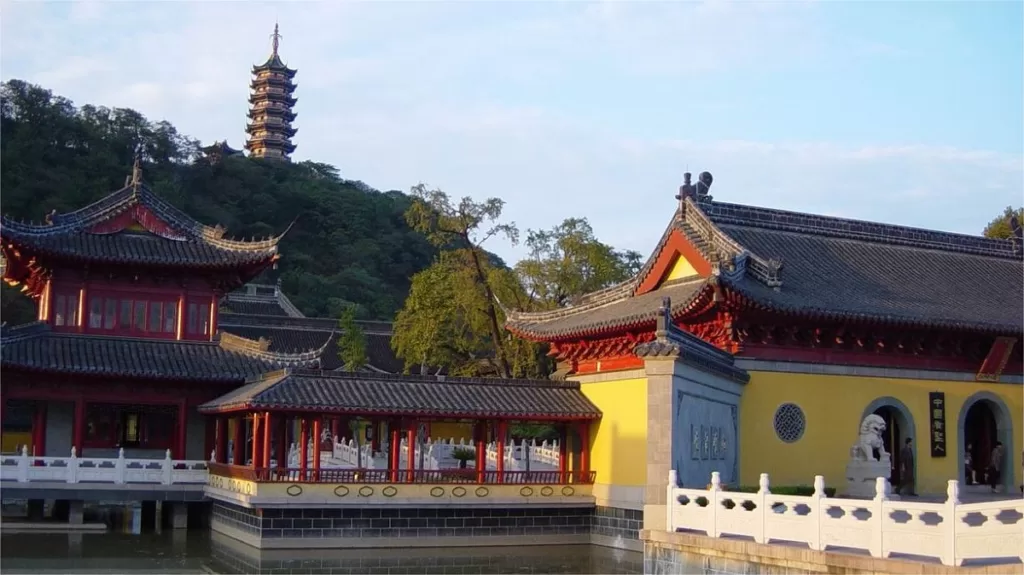Dinghui-Tempel, Zhenjiang - Eintrittskarten, Öffnungszeiten, Lage und Highlights


Dinghui Temple (定慧寺), originally established during the Eastern Han Dynasty in the Xingping era, boasts a history spanning over 1800 years. Initially named Puji Temple, it was referred to as Puji Zen Monastery during the Song Dynasty and later renamed Jiaoshan Temple during the Yuan Dynasty. However, during the Kangxi Emperor’s southern inspection in the Qing Dynasty, it was renamed Dinghui Temple, a name that has been retained ever since.
The name “Dinghui” holds profound significance in Buddhist practice. “Ding,” signifies the elimination of all selfish thoughts and distractions, emphasizing a highly concentrated state of mind. “Hui” represents the cultivation of wisdom through the threefold path of listening, contemplation, and practice. Together, “Dinghui” encapsulates the fundamental principles of Buddhist spiritual cultivation.
Dinghui Temple once reached its zenith during the Ming Dynasty, featuring an impressive complex with 98 halls and accommodating up to 3000 monks. The temple attracted tens of thousands of practitioners, further amplified by the presence of 18 adjacent monastic residences known as the “Eighteen Rooms,” solidifying Dinghui Temple’s prominent position among Buddhist Zen monasteries. With its rich history and grand scale, Dinghui Temple stands as a significant cultural and religious landmark, exemplifying the enduring legacy of Buddhist practice in the region.
Inhaltsübersicht
- Grundlegende Informationen
- Standort und Transport
- Highlights of Dinghui Temple
- Vlog about Dinghui Temple
- Attractions near Dinghui Temple
Grundlegende Informationen
| Geschätzte Dauer der Tour | 1 - 2 Stunden |
| Ticketpreis | 40 RMB included in the ticket for Jiaoshan Hill |
| Die Öffnungszeiten | 8.00 - 17.00 |
| Telefon Nummer | 0086-0511-88961110 |
Standort und Transport
Dinghui Temple is situated at the southern foothills of Mount Jiao in Zhenjiang, Provinz Jiangsu, China. Mount Jiao is located in the eastern part of Zhenjiang, surrounded by the Yangtze River. The mountain rises to an elevation of 70.7 meters and features two main peaks, with a smaller peak nestled between the eastern and western peaks.
Um dorthin zu gelangen, können Touristen den Bus 49, 76, 84, 104, 112 oder 204 nehmen und an der Haltestelle Jiaoshan Scenic Area (焦山风景区站) aussteigen.
Highlights of Dinghui Temple
Mahavira-Saal
Dinghui Temple, with its architectural marvels and cultural significance, offers a captivating experience for visitors. The main structure, the Mahavira Hall (大雄宝殿), still maintains its Ming Dynasty style, showcasing intricate dragon and phoenix carvings on the roof, a rare sight both domestically and internationally. The hall is a splendid display of golden brilliance and grandeur, creating a solemn atmosphere. Suspended in the air is a perpetual lamp, with the characters “香林” (Fragrant Forest) personally written by Emperor Kangxi glowing amidst the candlelight and incense, contributing to the temple’s dignified ambiance.
At the heart of the Mahavira Hall, three towering Buddhas – Sakyamuni, Medicine Buddha, and Amitabha – are enshrined on lotus thrones, radiating benevolence and solemnity. Flanking the hall are eighteen Arhats, vividly sculpted with diverse postures and expressions, each exuding a lively and lifelike presence. Behind the main Buddha, a wall relief depicts the island of Potalaka, featuring Avalokiteshvara in the center, accompanied by Sudhana (Shancai) on the left and Longnü (Dragon Maiden) on the right, guarding on either side. Other celestial beings are distributed throughout the island, crafted and arranged based on the legend of “Fifty-Three Visits to Sudhana” from the Buddhist Avatamsaka Sutra.
Ancient Ginko Trees
In front of the Mahavira Hall, two nearly 500-year-old Ginkgo trees, known as “living fossils,” stand tall and majestic. Despite enduring the passage of time and weathering countless storms, these ancient trees remain lush and vibrant, showcasing the resilience of nature. The Ming-era Ginkgo trees, abundant with fruits in both spring and autumn, continue to be a splendid sight and a prominent feature of Jiaoshan.
East Gushing Spring
Within the western courtyard of the Mahavira Hall, there is a man-made well known as “Dong Ling Quan” or “East Gushing Spring.” Legend has it that this was the site from which Jiao Guang collected water for alchemical purposes, hence its alternative name, the Alchemy Well.
Guanlan pavilion
To the east of Dinghui Temple lies the Guanlan Pavilion, a palace where Emperor Qianlong rested during his southern tour. This exquisite and compact ancient courtyard, a two-story building, offers panoramic views of the mighty Yangtze River. The pavilion, aptly named “Guanlan” (Observing Waves), was inspired by the spectacular waves and turbulent waters of the Yangtze. A row of ancient maples and poplars stands gracefully in front of the pavilion, and from its upper-level corridor, visitors can enjoy a sweeping view of the river, with a broad perspective encompassing lush flora, surging waves, fleeting clouds, and towering mountains – a picturesque masterpiece.
Vlog about Dinghui Temple
Attractions near Dinghui Temple

Xijin Ferry - eine Ansammlung von Kulturdenkmälern und historischen Stätten

Beigushan Hill - zerklüftetes Gelände und imposante Steinklippen

Jinshan Hill Scenic Area - Ein Ort, an dem sich ikonische Geschichten abspielen

Zhenjiang Museum - Haus mit über 30.000 Artefakten
Historische Stätten in Jiangsu, Zhenjiang Attraktionen